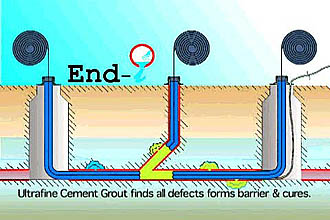Grouting

With the passage of time, an aging infrastructure will spring leaks, resulting in more water intake and infiltration to the system. According to EPA estimates, inflow accounts for almost half of all flow into treatment plants in the United States. The incoming water can lead to contamination, higher treatment costs, flooded lines and other problems. One method of fighting this problem is chemical grouting.
Like any other pipeline rehabilitation program, grouting takes experience to be truly successful. The process involves a CCTV truck for identifying the leaks, as well as mixing the grout chemicals, a packer machine that injects the grout and a winch to pull the packer through the pipe between manholes. The ideal use for grouting is joint repair in host pipes, manhole structures and lateral transitions. The hardening grout not only seals the pipe leak but also stabilizes the ground around the pipe, which helps reduce the damage from sinkholes. By eliminating infiltration, grouting helps reduce sanitary system overflows, road flooding and treatment cost.
Compared to the cost of relining and replacing pipelines, grouting offers significant financial savings, costing roughly one-fifth the price. It is best suited for smaller diameter pipes however, typically under 15 inch. The amount of grout required depends more on the voids outside the pipe than the size of the crack in the pipe.